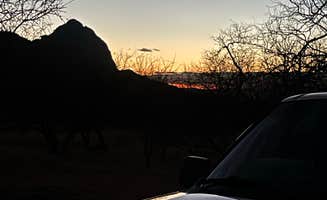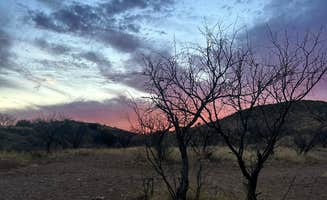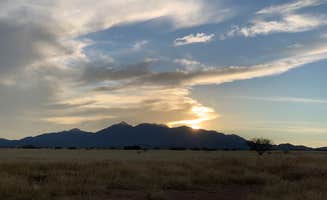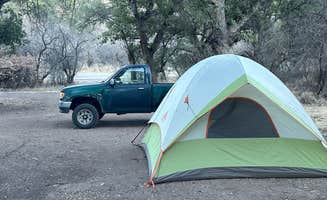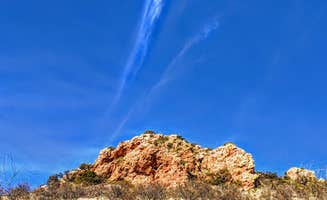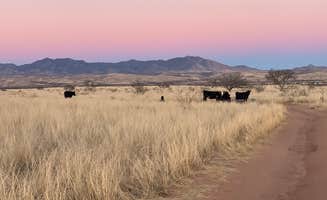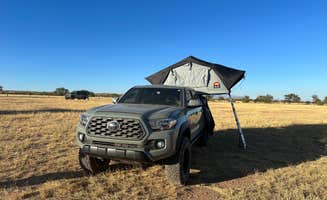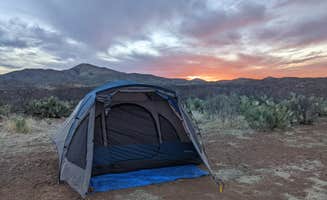Primitive camping near Amado, Arizona provides access to the rolling grasslands of southern Arizona at elevations ranging from 3,000 to 5,000 feet. The region experiences wide temperature swings, with summer highs often exceeding 100°F while winter nights can drop below freezing. Most campsites feature gravelly, desert soils with vegetation dominated by mesquite, prickly pear, and various desert grasses.
What to do
Wildlife viewing opportunities: At Cieneguita Dispersed Camping Area, visitors can observe diverse wildlife including pronghorns, Coues deer, and prairie dogs. "It is isolated, camp sites are well spaced and the scenery is great. There is no highway noise and the night time stars are brilliant. It is free range for cattle so you may wake up several mornings to see them in 'your backyard'. There are Coues deer (a small whitetail), pronghorns (get up early to see them), a prairie dog town, coyotes can be heard many nights, and all kinds of birds," notes camper Michael R.
Birding excursions: The dispersed camping areas provide excellent bases for birdwatching, particularly around Proctor Road Dispersed Camping - Site 3b. "This is a dusty, bumpy road with sites carved out amongst thorny trees. Wildlife (cows) is everywhere. Watch the weather report or you will be stuck in the mud trying to get out. The sunsets are wonderful and the birding is out of this world," shares Jeff H. The region is known for its exceptional bird diversity, especially during migration seasons.
Mountain biking routes: The network of forest roads around the primitive camping areas near Amado provides excellent mountain biking terrain. One camper at Harshaw Road Dispersed Camping - San Rafael Canyon noted, "This dispersed camping area was a lot more secluded and quieter than I expected. My friend and I were looking to camp overnight before going on a gravel bike ride in the area. Harshaw Road was already along the bike route, so this was an ideal location."
What campers like
Dark night skies: The remote nature of these primitive campsites near Amado creates exceptional stargazing opportunities. A camper at Cieneguita Dispersed Camping Area - Las Cienegas National Conservation Area shared, "I was traveling from Tucson to Sonoita and had myself a nice overnight. I saw one other camper here, but never heard them. Beautiful secluded space, bugs weren't too bad. LOTS of nature sounds... And the birds are everywhere! It's super awesome!"
Varied camping terrain: The region offers diverse camping experiences from flat grasslands to more rugged, elevated sites. At Proctor Road Dispersed Camping, one camper observed, "Loved our easy access experience. It's a lovely, late sunset. This site is a little lower than others with a better view perhaps, but the trees provide a better buffer against the wind. This whole road here is quiet, and with very little traffic."
Proximity to small towns: Campers appreciate being able to access supplies in nearby communities while enjoying primitive camping. "Bonus that this is pretty close to Patagonia which came in handy when we couldn't make coffee in the morning," noted one camper at Harshaw Road. Another mentioned, "We are 8 miles or about 20 minutes from downtown Patagonia which has a few little shops and restaurants as well as gas and propane though things seem to be a bit more expensive here."
What you should know
Vehicle requirements: Many primitive camping areas near Amado demand high-clearance vehicles. A camper at Madera Canyon on Proctor Road advised: "Took my Jeep off the main road onto Proctor to check out the dispersed camping. I would not bring my 30' class A in there. I've had it in some knarly places. Looks like some OK spots not too far off the main road but...Don't go there unless you have a high clearance vehicle. i.e. 4x4 Van, 4x4 pickup and camper."
Weather precautions: Flash flooding can occur during monsoon season (July-September), and winter nights drop below freezing. "Watch the weather report or you will be stuck in the mud trying to get out," warns one camper about Proctor Road conditions.
Seasonal considerations: Spring (March-May) and fall (September-November) offer the most moderate temperatures for primitive camping near Amado. Summer temperatures regularly exceed 95°F during the day, requiring additional water supplies and shade considerations.
Tips for camping with families
Safety planning: When primitive camping with children near Amado, establish clear boundaries and emergency protocols. A camper at Arivaca Lake shared: "We camped here March 17th, a little warm in the day (high 85) but nice and cool at night. There are several fire rings in the main parking lot. You can get there in a sedan. There is an upper lot that you can camp at with fire rings and mediocre lake views."
Wildlife awareness: Teach children about local wildlife including snakes, scorpions, and javelinas. One camper noted, "We camped here for two nights with a nice view of elephant head. It is an open range so there are cows walking around. There are quite a few camping spots but had all of them filled by the time we made camp on Friday afternoon. One of the really downsides was we had two skunks walk through our site early Saturday morning and one did spray our 10 months old puppy."
Site selection: Choose sites with natural shade if possible, as summer temperatures in primitive camping areas near Amado can be extreme. A camper at Harshaw Road noted, "We stayed in a larger site on the road closer to the mine entrance. Liked our larger site and had it to ourselves for a night."
Tips from RVers
Access limitations: Many primitive camping areas near Amado have limited accessibility for larger RVs. "The moderately difficult access limits to trucks with off road trailers mostly," noted one camper at Proctor Road Dispersed Camping.
Water management: No potable water is available at most primitive camping sites near Amado. A camper at Snyder Hill BLM Camping Area shared: "No water, electricity, or dump. For $15 you can dump and fill at right on San Joaquin at Justin's RV park or there are free options in town (20 minute drive)."
Site exploration: RVers should scout potential primitive camping locations before committing. "If coming in with a lower ground clearance vehicle, or a longer one that may bottom out you might want to scout them out first. Once inside the camping area there are lots of spots to choose from. The smaller and more nimble the vehicle gives more choices," advised one Snyder Hill camper.




